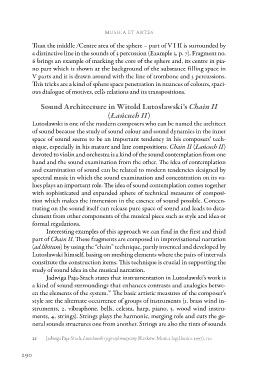Page 292 - Vinkler, Jonatan, in Jernej Weiss. ur. 2014. Musica et Artes: ob osemdesetletnici Primoža Kureta. Koper: Založba Univerze na Primorskem.
P. 292
musica et artes
Than the middle /Centre area of the sphere – part of V I II is surrounded by
a distinctive line in the sounds of 3 percussion (Example 3, p. 7). Fragment no.
6 brings an example of marking the core of the sphere and, its centre in pia-
no part which is shown at the background of the substance filling space in
V parts and it is drawn around with the line of trombone and 3 percussions.
This tricks are a kind of sphere space penetration in nuances of colours, spaci-
ous dialogue of motives, cells relations and its transpositions.
Sound Architecture in Witold Lutosławski’s Chain II
(Łańcuch II)
Lutosławski is one of the modern composers who can be named the architect
of sound because the study of sound colour and sound dynamics in the inner
space of sound seems to be an important tendency in his composers’ tech-
nique, especially in his mature and late compositions. Chain II (Łańcuch II)
devoted to violin and orchestra is a kind of the sound contemplation from one
hand and the sound examination from the other. The idea of contemplation
and examination of sound can be related to modern tendencies designed by
spectral music in which the sound examination and concentration on its va-
lues plays an important role. The idea of sound contemplation comes together
with sophisticated and expanded sphere of technical measures of composi-
tion which makes the immersion in the essence of sound possible. Concen-
trating on the sound itself can release pure space of sound and leads to deta-
chment from other components of the musical piece such as style and idea or
formal regulations.
Interesting examples of this approach we can find in the first and third
part of Chain II. These fragments are composed in improvisational narration
(ad libitum) by using the “chain” technique, partly invented and developed by
Lutosławski himself, basing on meshing elements where the pairs of intervals
constitute the construction items. This technique is crucial in supporting the
study of sound idea in the musical narration.
Jadwiga Paja-Stach states that instrumentation in Lutosławski’s work is
a kind of sound surroundings that enhances contrasts and analogies betwe-
en the elements of the system.21 The basic artistic measures of the composer’s
style are the alternate occurrence of groups of instruments (1. brass wind in-
struments, 2. vibraphone, bells, celesta, harp, piano, 3. wood wind instru-
ments, 4. strings). Strings plays the harmonic, merging role and cuts the ge-
neral sounds structures one from another. Strings are also the tints of sounds
21 Jadwiga Paja-Stach, Lutosławski i jego styl muzyczny (Kraków: Musica Iagellonica, 1997), 130.
290
Than the middle /Centre area of the sphere – part of V I II is surrounded by
a distinctive line in the sounds of 3 percussion (Example 3, p. 7). Fragment no.
6 brings an example of marking the core of the sphere and, its centre in pia-
no part which is shown at the background of the substance filling space in
V parts and it is drawn around with the line of trombone and 3 percussions.
This tricks are a kind of sphere space penetration in nuances of colours, spaci-
ous dialogue of motives, cells relations and its transpositions.
Sound Architecture in Witold Lutosławski’s Chain II
(Łańcuch II)
Lutosławski is one of the modern composers who can be named the architect
of sound because the study of sound colour and sound dynamics in the inner
space of sound seems to be an important tendency in his composers’ tech-
nique, especially in his mature and late compositions. Chain II (Łańcuch II)
devoted to violin and orchestra is a kind of the sound contemplation from one
hand and the sound examination from the other. The idea of contemplation
and examination of sound can be related to modern tendencies designed by
spectral music in which the sound examination and concentration on its va-
lues plays an important role. The idea of sound contemplation comes together
with sophisticated and expanded sphere of technical measures of composi-
tion which makes the immersion in the essence of sound possible. Concen-
trating on the sound itself can release pure space of sound and leads to deta-
chment from other components of the musical piece such as style and idea or
formal regulations.
Interesting examples of this approach we can find in the first and third
part of Chain II. These fragments are composed in improvisational narration
(ad libitum) by using the “chain” technique, partly invented and developed by
Lutosławski himself, basing on meshing elements where the pairs of intervals
constitute the construction items. This technique is crucial in supporting the
study of sound idea in the musical narration.
Jadwiga Paja-Stach states that instrumentation in Lutosławski’s work is
a kind of sound surroundings that enhances contrasts and analogies betwe-
en the elements of the system.21 The basic artistic measures of the composer’s
style are the alternate occurrence of groups of instruments (1. brass wind in-
struments, 2. vibraphone, bells, celesta, harp, piano, 3. wood wind instru-
ments, 4. strings). Strings plays the harmonic, merging role and cuts the ge-
neral sounds structures one from another. Strings are also the tints of sounds
21 Jadwiga Paja-Stach, Lutosławski i jego styl muzyczny (Kraków: Musica Iagellonica, 1997), 130.
290


